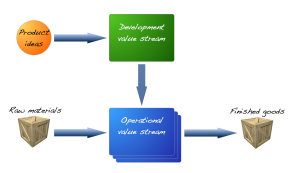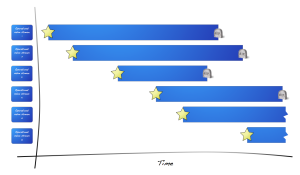The Why of FlowChain: Deliberate Continuous Improvement
In my career, working with hundreds of companies, I’ve almost never seen organisations* take a truly deliberate approach to continuous improvement. It’s nearly always treated as an afterthought or add-on to business-as-usual (BAU). But real transformation requires making continuous improvement an integral and core part of daily work. This is the “why” behind FlowChain – enabling deliberate, in-band continuous improvement.
In other words, applying the same disciplines from product development, delivery, etc. to the business (sic) of delivering continuous improvements – continuously improving the way the work works.
What Is FlowChain?
So what is FlowChain? At its core, it is a system for managing flow – both the flow of outputs and the flow of improvements to the way the work works, concurrently and by the same means. And by “flow”, I mean the steady progress of work from request to completion through all steps in a process. Flow is optimised when the right work is happening at the right time by the right people. Roadblocks, delays, and waste are minimised or eliminated.
Flow
Optimising flow delivers the following benefits:
- Increased productivity – less time wasted, more work completed
- Improved quality – fewer defects, rework minimised
- Better customer service – faster response times, reliability
- Higher employee engagement – less frustration, more joy
But achieving flow requires continuous improvement. Problems must be made visible. Waste must be reduced iteratively. Roadblocks must be cleared continuously.
This is why FlowChain incorporates improvement into its regular rhythm. Each cycle follows a deliberate sequence:
- Plan – Select and sequence the upcoming work.
- Execute – Complete the work while tackling issues.
- Review – Analyse completed work and identify improvements.
- Adjust – Make changes to improve flow.
Unlike most continuous improvement efforts – that are separate from BAU – FlowChain makes improvement an integral in-band activity. The rapid cycles provide frequent opportunities to reflect, gain insights, and act.
Compounding Benefits
Over time, the compounding benefits are immense. Teams develop a “flow habit”, where improving flow becomes second nature. Powerful capabilities like root cause analysis, A3 problem-solving, improvement katas, and change management are honed.
In my experience, this deliberate approach is transformative. Teams gain tremendous agency to systematically improve their own flow. The organisation as a whole cultivates a culture of continuous improvement. And customers experience ever-better service and responsiveness.
The “why” of FlowChain is simple – create focus, visibility, accountability, and agency to drive continuous improvement. The results – ever better flow, reduced waste, and sustainable transformation. Deliberate, in-band continuous improvement stops being an aspiration and becomes a reality.
*Ask me about the exception.


